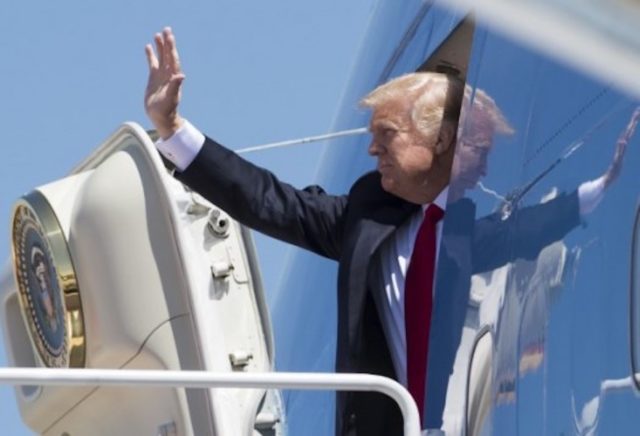It is worth getting out of the weeds of Washington on occasion and looking at the big picture. This is one of those occasions.
President Trump is going to Israel, visiting the one stable, prosperous, multiethnic, multicultural, democratic ally the United States has in a region marked by war, repression, and corruption. When he visits the Western Wall, he will be the first sitting president to do so — Barack Obama came as a candidate, George W. Bush as governor of Texas, George H.W. Bush as vice president, and Bill Clinton both before and after his presidency.
The fact that he will visit during the week of the 50th anniversary of the reunification of Jerusalem is a potent symbol of American support for Israel’s determination to keep the city open to all religious faiths – and specifically open to Jewish worship. There is no forgetting that only for the past 50 years, only under Israeli control, have Jews been able to study, visit, and pray at Judaism’s holiest sites. During Jordanian occupation of the eastern side of the city, and for the 500 years of Ottoman rule before that, Jews were restricted or banned entirely from their heritage.
The President’s visit to the holiest site in the Jewish world — accessible to Jews for less than his lifetime – is an exclamation point.
The reunification of Jerusalem was, of course, accomplished in the context of the Six-Day War, and the presidential visit comes in that context as well. The war was waged by Arab States unreconciled to Jewish sovereignty in any part of the historic Jewish homeland. Visiting on the eve of the commemoration of Israel’s defense of its place and defense of its rights, Mr. Trump has chosen a time ripe with symbolism to assert America’s longstanding — and newly recovered — shoulder-to-shoulder defense of Israel’s legitimacy and right to sovereign security.
Mr. Trump was preceded in Israel by Defense Secretary James Mattis and Chairman of the Joint Chiefs of Staff Joseph Dunford. Their visits were aimed at deepening U.S.-Israeli security cooperation and reversing the previous administration’s plan to enhance the role of Iran in the region and decrease American influence. Mr. Trump can be expected to praise the first and find additional ways to work with Israel to constrain Iran’s freedom of action in both missile and nuclear development, and in military activity in Syria, Yemen and the Persian Gulf.
The President will visit with Arab leadership in the Gulf before arriving in Israel. The Sunni Arab world knows Iranian aggression and radical Islam are its fundamental security problems, not Israel. They are thrilled with the administration’s harder line on Iran, and the understanding that American influence and American presence matters. They want to be on Mr. Trump’s “good side,” and that’s helpful. Responding to his interest in Israeli-Palestinian talks, a new incarnation of an “Arab Peace Plan” has been floated. Trying to appear reasonable, the Arabs say Israel has only to “stop building settlements in the West Bank and ease trade restrictions in the Gaza Strip.” In exchange, they will allow Israel access to Gulf State airspace and enable direct communications with Israel.
The good news is that the plan doesn’t appear to try to settle the whole problem in a grand gesture. It does get closer to reality — the prior “Arab Peace Plan” in 2002 required that Israel withdraw from all the territory acquired in the 1967 war, including Jerusalem, before the Arab States would consider — consider, mind you — ending their state of war with Israel. As things go, this is an improvement and an affirmation of the points made by Mr. Trump and Prime Minister Netanyahu made in their joint press conference in February that progress on Palestinian-Israeli accommodation might be accomplished in a regional context.
The Palestinians, it appears, took the possibility that they will be sidelined to heart and went one better than the Arab States, dropping their eight-year insistence on an Israeli building freeze as a precondition to negotiations. U.S. Ambassador to Israel David Friedman put a nail in the coffin of “settlement freezes,” saying, “The U.S. won’t dictate how you should live together, that is something you will have to decide on your own.” Having lost the battle on that issue, the Palestinians will have to be content with the President’s visit to the Church of the Nativity in Bethlehem.
Are there glitches? Yes. There is a long way to go before the Arab States meet their UN-mandated obligation to provide Israel with “termination of all states of belligerency and respect for the sovereignty, territorial integrity and political independence of all States in the region.” The Palestinians aren’t likely to do it before their political and financial masters do. And Americans David Berns and Jonathan Schrier, working in the U.S. Consulate in Jerusalem — which sees itself as an embassy to the fictitious State of Palestine — tried to create a firestorm over an issue of sovereignty. It was more like a paper fire in a wastebasket, embarrassing the President, but doing no damage.
But those are points that can be left for later.
When the President of the United States arrives in Israel as Israel prepares to commemorate 50 years of the Six-Day War and the reunification of Jerusalem, Americans should be pleased and proud that President Trump chose this time and this place to cement relations with Israel — our ally and friend.






